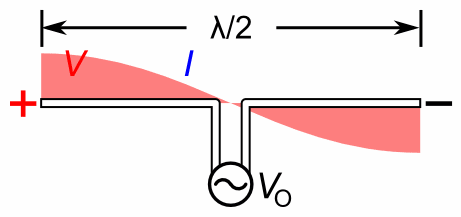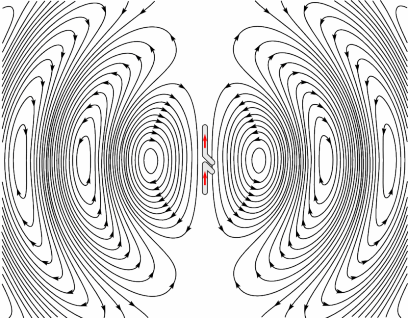How does antenna radiation occur?
We will try to keep the discourse simple as we try to unravel the mysteries of antenna radiation. Does it mean that any wire carrying alternating current behaves like an antenna? The answer is both yes and no. Theoretically, when alternating current flows through a conductor (wire, pipe, rod, etc.) will potentially convert some of the electrical energy into electromagnetic (EM) wave radiation. How small or how large is the quantum of EM energy radiated from the conductor will depend on several factors which include the geometrical layout of the wire, length of the wire in relation to the wavelength (λ) or frequency (1/λ) of the AC excitation source, its proximity to another conductor carrying return current of similar magnitude, etc.
Let us examine and build upon these concepts as we try to understand how an antenna works. Based on what we have stated so far, it is natural to assume that even our household wiring, power transmission lines, etc are also prone to radiate EM waves. The assumption is correct, however, there is a caveat. Such electrical wirings are very poor radiators of EM waves. Although they produce significant electric and magnetic field flux in their vicinity, they are very bad EM radiators at 50/60 Hz frequency that is typically used for power transmission and distribution. The wavelength is in the order of 6000/5000 Km respectively for 50/60 Hz. The length of household wiring or distribution lines is very small in proportion to the wavelength to be a worthwhile EM energy radiator. Moreover, a return current wire is generally always laid out together (phase and neutral) in close proximity to each other making the geometry unsuitable for EM radiation.
Voltage and Current on a Dipole
Now, let us come straight to how does an antenna radiate? Structurally, there are several tens (if not hundreds) of different types of antennas available, many of which have quite unique performance characteristics and radiation patterns. However, in terms of technical principles, there aren’t too many variations. All of them are either a standing-wave or a traveling-wave antenna and also they are either voltage-driven or current-driven. Moreover, the fundamental principle of radiation is similar to every antenna. Therefore, we will examine a typical dipole which should suffice for understanding the underlying radiation principle.
A dipole is a length of conductor driven by an electrical energy source at a point in the middle of its length. The length of a typical resonant dipole is half the wavelength (1/2 λ). This length makes it conducive for antenna radiation. The excitation RF energy source which is applied at the middle of the conductor length is a voltage source. This is a sinusoidal voltage which starts by producing an RF electric field which makes the potential at one end of the 1/2 λ length wire negative and the other end positive. A current (electric charge) starts flowing from one end of the conductor to the other.
Since the length of the conductor is 1/2 λ the time needed for the movement of electric charge (current) to flow from one end to the other (at the velocity of light C) is equal to 1/2 cycle duration of the frequency of RF excitation. Hence, precisely at the moment that the current reaches the other end of the conductor which would be a dead-end with the current having no place to travel further, the RF excitation source completes its 1/2 cycle and reverses the phase. This results in the polarity of the voltage at the ends of the conductor changing, thus forcing a reversal in the direction of flow of current on the 1/2 λ length of the dipole.
This process of repetitive reversal of direction of current flow on the dipole conductor continues indefinitely as long as the RF excitation is continued to be applied. Therefore, there is a continuous oscillatory to-and-fro movement of charge (current flow) along the length of the dipole. Despite the fact that the dipole wire is open at the ends and does not form a closed circuit as one might traditionally expect as a necessary condition for current flow, the current on the dipole continues to flow in an oscillatory manner across the 1/2 λ length of wire. The flowing current is oblivious to the physical discontinuity of the circuit at the open ends of the dipole. This is how RF transmitting current flows on a dipole despite no physical closed-circuit loop. The flow of RF current without discontinuity in a 1/2λ open-ended dipole lays the ground for antenna radiation to occur.
Electric and Magnetic field along a Dipole
So far, we have established the principle of RF current flow on a dipole. Now, we need to examine how the flow of RF current on the dipole along with the electric potential due to the voltage translate into radiation of EM waves. The physical structure of the layout of dipole elements is the key to antenna radiation. The two halves of the dipole are typically laid out in line with one another. In case, the two halves of the dipole wire were to be laid out parallel to each other by turning them both at 90° then it would look like a length of a very familiar parallel open-wire transmission line (TL).
Factually, such a wire layout will indeed turn into a TL and become a very poor radiator by confining the RF energy and preventing radiation. The electric field between the two parallel wires produced by the applied voltage is confined in the space between the wires like a capacitor, while the magnetic field produced by the current around each wire happens to be of opposite polarity and equal magnitude. Since the spacing between the wires is very small in comparison to the wavelength (λ), the opposite polarity magnetic fields cancel each other and do not produce any significant residual field outsides the confines of the wire pair. Hence, this parallel wire scenario would not radiate energy but would efficiently transfer it from one end to the other. This would make the parallel wire geometry a good transmission line.
In view of the above, let us revisit the original structural geometry of the dipole where the wires connected to the RF excitation source are not laid out in parallel but in an inline geometry as it is in the case of a dipole. What happens now? Why does this alteration in geometry turn these wires into an efficient antenna? The reason is that electric energy fields are no more confined. The electric field produced by the voltage source has to now cut across a wide space around the antenna structure.
Similarly, the magnetic fields produced by the flow of oscillating current on each half of the wire segments of the dipole (as explained earlier) being in a plane which is perpendicular to the dipole wire do not merge or interact with the magnetic field on the other half of the dipole element. Like the alternating RF electric field, the alternating RF magnetic field too gets coupled and extends well into the surrounding medium (free-space, air, vacuum, etc). These fields which extend into the medium around the antenna need to quickly build up and collapse while reversing polarity in consonance with the excitation source.
However, these fields are unable to collapse quickly enough with the phase reversal of the RF excitation source and they get pushed outwards by the next excitation cycle which by now has already started to builds up. The fields which are pushed outwards become orphaned as they get detached from the antenna wire. They continue to be pushed away more and more by subsequent excitation cycles. We will now see how these detached fields gradually transform through a three-stage antenna radiation process to convert into EM waves which become completely independent of the source antenna to eventually become self-sustaining and travel freely through the propagation medium.
Formation of Electromagnetic (EM) Wave
Prior to the detachment phase, the energy fields behave similarly to normal electric and magnetic fields with the ability to exhibit the usual mutual coupling properties. So far, the electric and magnetic fields retain their separate properties. Any other conductor within this field zone can receive energy transfer from the driven dipole and the extent of loading of the dipole energy source would be proportionate to the loading on the coupled conductor within the field. This is quite similar to the coupling between the primary and secondary winding of a transformer through magnetic field mutual coupling.
So far what we witness is not an electromagnetic (EM) field. This field region around the antenna is called the Induction field or the Rayleigh zone. There is no EM wave generation within the induction (near) field. The induction field region comes in very useful for Yagi antennas or any other antenna based on parasitic elements. But that’s another story. This principle of near-field coupling is also used in passive RFID systems.
Now, let us go back and take a closer look at the fields that got detached from the dipole radiating element. They are the starting point of the building blocks that eventually get converted into EM waves resulting in the phenomenon of antenna radiation. The detached fields, thereafter travel unabated and on their own through free-space or any other RF propagation medium. At the initial stage of detached electric and magnetic fields, they do not form EM waves because there is a 90° phase shift between the two field components. Hence, they form a reactive load on the antenna.
As these detached fields get pushed further away at the velocity of light, they encounter a mutual phase shift due to which after a point their phase difference becomes zero, and both electric fields, as well as the magnetic field, are now in phase. That is when the EM wave starts forming. This intermediate zone between the induction (near) field and the point of formation of EM waves is called the Fresnel zone. Typically, the Rayleigh zone and the Fresnel zone are collectively called the Near field of the antenna
Beyond the Fresnel zone described above, the magic happens. The in-phase but orthogonally oriented electric and magnetic fields combine to form what we know as electromagnetic (EM) waves. This had been postulated in the year 1864 by Maxwell in his famous treatise on electromagnetism. It is noteworthy that when Maxwell postulated his theory there was no radio, which was invented much later. Maxwell found that the electric field and the magnetic field coexist together even without the presence of a conductor. The two fields need to be spatially orthogonal to each other and should be in phase. Under these circumstances, the energy contained in the fields will mutually sustain one another indefinitely if there is a lossless medium.
In other words, as the magnetic field collapses it would transfer energy to the electric field which would build up, while a collapsing electric field will transfer energy to build up a magnetic field. As this alternating process between the magnetic and electric fields continues, the combined energy would travel (propagate) at the velocity of light in a direction perpendicular to both the fields. This is what is called the EM wave. Unlike the separate magnetic and electric fields in the induction (near) field zone which were not detached but connected to the antenna element, the EM wave is totally detached from the transmitting antenna. In fact, the antenna radiation process just occurred as a consequence of EM wave generation.
Once created, the EM wave antenna radiation is self-sustaining and independently contains all the energy which it received at the time of its formation within its electric and magnetic field components. Therefore, any form of loading on the propagating EM wave by receiving antennas do not cause any counter-effect on the transmitting antenna. Irrespective of whether there is one far-end receiving antenna or millions of them for receiving and retrieving the signal, the transmitting antenna does not experience any additional loading unlike the case of near field coupling. The region beyond the Fresnel zone where the EM waves form for antenna radiation to take place is known as the Radiation field, or Far-field, or the Fraunhofer region.


















